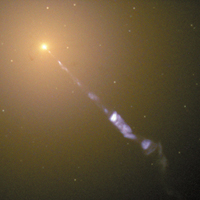black hole of typically 100 million solar masses, which emits streams of matter with
relativistic velocity, the so-called jets. A nice example of such a jet is shown
in the figure below.

This image of the nearby AGN M87 has been taken with the Hubble Space Telescope.
The core of M87 is displayed as bright, yellowish knot in the upper left corner,
from where the jet emanates in the form of an aligned series of blueish emission features.
We know today that the material in these jets moves with nearly the speed of
light, which results in a strong collimation and amplification of jet radiation in the
direction of the jet axis. Those AGN viewed head-on are therefore sources of very
rapid and luminous emission from radio frequencies to gamma-ray energies. But how is radiation produced in these jets? And how do the radiating energetic
particles obtain their energy?
We study collective interactions between the jet material and the interstellar medium
of the AGN host galaxy, through which the jet propagates. The density of matter in
these objects is so low, that the particles do not interact via collisions as in the earth
atmosphere, but via electromagnetic turbulence. As shown in the figure below, we
model the jet as consisting of individual clouds of matter which relativistically move
through interstellar matter. This causes a classic two-stream instability and thus
provides relativistic particles in the jet and hence radiation. Some of the relativistic
particles return to the region in front of the jet, where they would pre-accelerate
the interstellar medium. This results in a highly non-linear relationship between the
interstellar material, the jet, and the relativistic particles therein, the study of which
requires both analytical and numerical methods such as extensive particle-in-cell
simulations.
